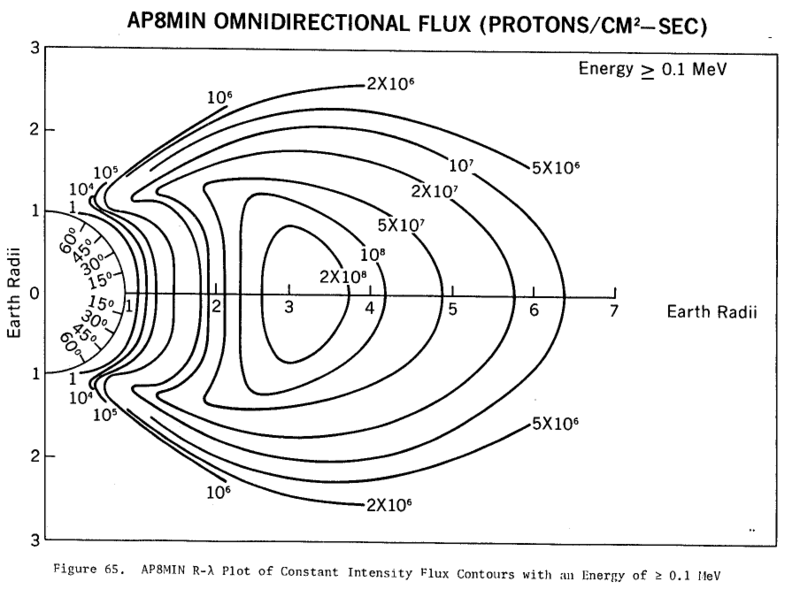|
Size: 1287
Comment:
|
Size: 2718
Comment:
|
| Deletions are marked like this. | Additions are marked like this. |
| Line 11: | Line 11: |
| HfO or the SiO2, leaving a residual imbalance? In any case, it does demonstrate how modern gate oxides may be much more rad hard than older technologies. | !HfO or the !SiO2, leaving a residual imbalance? In any case, it does demonstrate how modern gate oxides may be much more rad hard than older technologies. === Tantalum shielding === Tantalum capacitors over the tops and bottoms of chips can act as both shielding and bypass. Tantalum has a density of 16.7 gm/cm^3^ at 300K, so a 30 micron thick layer would add 0.05 grams/cm^2^ of shielding. According to [[SMAD]] figure 8-18, that might reduce the 1-15keV dose by a factor of 3-5, and perhaps a factor of 2 for electrons (figure 8-19). [ More accurate information needed] . To accommodate the extra thickness in the launch stack, the processors and memory and other chips might sit in interdigitated positions on every other server-sat. MORE LATER {{{ '''Question''' - does a small tantalum cap short out when an ionizing particle passes through it? That would actually be good, because it could remove power from the segment of a chip that is being hit, possibly removing drift fields from the gate oxide and helping immobilize charges. }}} === surface charging === Most of the area of a server-sat will be solar cells, with low voltages across the surface. If the LCD thrusters have glass covers with Indium oxide conductors on both sides, the outer conductors may be grounded relative to the rest of the server-sat. As all surfaces will be conductive, and at voltages less than one or two volts, there is no opportunity for arcing across surfaces, which sometimes happens to geosynchronous satellites in the solar wind ( see [[SMAD]] page 212-214 ). |
The Space Environment
The inner and outer van Allen belts
MORE LATER
Ionizing radiation and semiconductor damage
Silicon dioxide develops a positive charge when irradiated. An ionizing particle passes through, and generates hole-electron pairs. The electrons are highly mobile, and diffuse or drift out, while the holes get trapped, and leave a positive charge. Hafnium oxide develops a negative charge, trapping electrons. A stack of both shows promise as a rad-hard gate oxide, withstanding 10Mrad from a Cobalt 60 source with minimal shifts. I wonder if that is tuned for Co60? Perhaps a wider spectrum of radiation energies, as would be found in the Van Allen belt, would preferentially charge either the !HfO or the SiO2, leaving a residual imbalance? In any case, it does demonstrate how modern gate oxides may be much more rad hard than older technologies.
Tantalum shielding
Tantalum capacitors over the tops and bottoms of chips can act as both shielding and bypass. Tantalum has a density of 16.7 gm/cm3 at 300K, so a 30 micron thick layer would add 0.05 grams/cm2 of shielding. According to SMAD figure 8-18, that might reduce the 1-15keV dose by a factor of 3-5, and perhaps a factor of 2 for electrons (figure 8-19). [ More accurate information needed] . To accommodate the extra thickness in the launch stack, the processors and memory and other chips might sit in interdigitated positions on every other server-sat.
MORE LATER
'''Question''' - does a small tantalum cap short out when an ionizing particle passes through it? That would actually be good, because it could remove power from the segment of a chip that is being hit, possibly removing drift fields from the gate oxide and helping immobilize charges.
surface charging
Most of the area of a server-sat will be solar cells, with low voltages across the surface. If the LCD thrusters have glass covers with Indium oxide conductors on both sides, the outer conductors may be grounded relative to the rest of the server-sat. As all surfaces will be conductive, and at voltages less than one or two volts, there is no opportunity for arcing across surfaces, which sometimes happens to geosynchronous satellites in the solar wind ( see SMAD page 212-214 ).
MORE LATER
Ionizing radiation, charge upsets and latchup
MORE LATER
Drag
MORE LATER
References
http://www.isde.vanderbilt.edu/content/muri_2008/dixit_muri2008.pdf Sriram Dixit et. al. at Vanderbilt University. Recent work on HfO/SiO2 stacked gates and radiation resistance.

